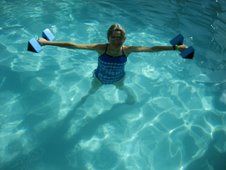IN THE POOL:
Whether or not you're a water lover, you'll want to at least try water exercises. Numerous studies report that this form of low-impact exercise -- especially when done in warm water -- can help reduce fibromyalgia pain and stiffness, as well as fatigue and depression in many people with fibromyalgia. And you don't have to endure the back-and-forth monotony of swimming laps if that's not for you. There are a variety of fun, get-wet workouts to choose from -- including music-based aqua aerobics, underwater walking or jogging, strength training, stretching, and water-based relaxation therapies like yoga, tai chi, and Watsu.
STRENGTH TRAINING:
You don't have to be a body builder. But lifting light weights or doing other types of resistance-based strength training might improve your fibromyalgia symptoms. Fewer fibromyalgia studies have been done on strength training than on other exercise forms, but resistance training shows equal promise in its ability to relieve fibro pain and fatigue, improve sleep, reduce the number of tender points, and dampen depression in people with fibromyalgia. Strength training also may prevent weakening and loss of muscle mass (atrophy) to boot.
WALKING:
One of the easiest things you can do is lace up your walking shoes and hit the sidewalk. Research suggests that mildly to moderately intense walking may dial down fibromyalgia pain and fatigue just as well as other forms of aerobic exercise do. But ask your rheumatologist or physical therapist how fast, how far, and how often you should walk when starting out. And build up your walks gradually. How much you should ultimately walk will depend on several factors, including your age, your fitness and activity levels, the severity of your fibromyalgia symptoms, and whether the activity worsens or improves your fibro pain and fatigue. Keep in mind that it’s probably also best to do mini walks here and there rather than take one long walk.
Stick with Exercise for Fibromyalgia
The best way to ensure exercise improves your fibromyalgia? Don't stop once you start. Getting fit and controlling symptoms does not have a beginning and an end. And being a faithful follower of your exercise program is what brings continuous results. Research suggests that the symptom-improving benefits of any exercise program may take up to 4 weeks to fully kick in, so be patient. And remember, whether you are just starting out or have been at it for a while, if exercise ever hurts or makes your fibro symptoms worse, stop. Break it up. Exercise in small spurts. And keep it low-key. The last thing you want is to overdo it. And if you can't find anything that works for you, check in with your doctor or physical therapist as soon as possible to find out what other fibromyalgia treatments you might need to get back on a more active path.
(Real Age, 6/14/12)


No comments:
Post a Comment